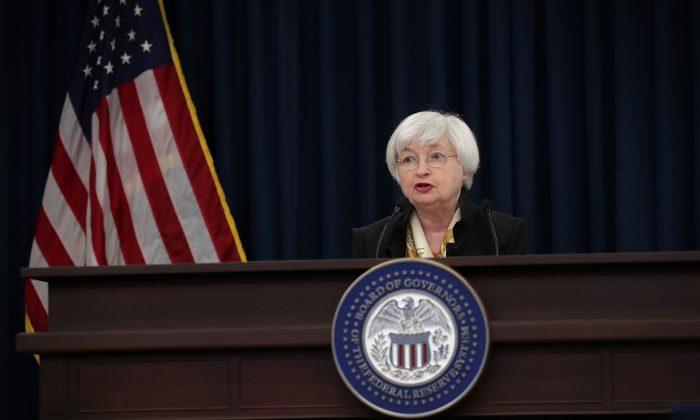The Fed sees rates rising eventually, although they won’t rise as fast or as high as previously thought. The U.S. central bank left its key rate unchanged at 0.25 to 0.50 percent on June 15.
The Federal Reserve’s statement was little changed from April. It noted labor market improvement has slowed, but household spending has strengthened. The recent volatility in financial markets due to a greater chance of “Brexit”—the U.K. leaving the E.U.—factored into the Fed’s decision, but the statement didn’t play up global developments.
Regarding Brexit, BMO deputy chief economist Michael Gregory says, “It’s creating volatility and weakness in global financial markets that is rippling on U.S. shores.”
The VIX—sometimes called “fear index”—is up over 40 percent in the last week. In the last week, the pound sterling suffered its biggest weekly drop since February. Globally, 10-year bond yields hit record lows in Germany, Japan, U.K., and Switzerland reflecting a flight to safety and quality.
Bouts of volatility have pushed the Fed to the sideline recently. Last summer, the Fed was leaning toward hiking rates in September, but China’s growth concerns came to the fore in August sparking a market selloff. A similar scenario played out in January and the Fed pared back its own expectation for 2016 rate hikes from four to two in March.
Fed chair Janet Yellen said a “cautious approach to monetary policy is appropriate,” given economic indicators are painting a mixed picture.
Bank of America Merrill Lynch’s June Fund Manager Survey showed two-thirds of investors expected a hawkish Fed but no June rate hike. A bit less than 20 percent of investors expected either a dovish Fed with no June rate hike or a 0.25 percent rate hike. The first less-than-20 percent camp was correct.
Labor Market Downshifts
The May labor report that showed employers added just 38,000 jobs took a June rate hike off the table.
“This was a very weak report and the sharp falloff in the headline number along with the negative revisions speak to the dramatic slowing in underlying labor market momentum,” said Millan Mulraine, TD Securities deputy U.S. chief macro strategist in a note on June 3.
Yellen stressed it’s “important not to overreact to one of two monthly readings.” Gregory says job growth will trend in the 150K- to 200K-range and eventually the 100K- to 150K-range.
“Often when you get these downshifts, it happens not in an evolutionary sense, but a revolutionary sense,” Gregory tells Epoch Times. But Gregory suggests the pace of job growth in April and May is a bit too slow.
New Normal
Now, six FOMC participants think just one rate hike in 2016 is appropriate, whereas in March, only one participant felt that way.
Again, the Fed’s year-end median fed funds rate for at least three of the years it projects has been lowered. For 2016, two rate hikes are still projected. For 2017, the median fed funds rate is lower by 0.25 percent to 1.625 percent. It is sharply lower in 2018 by 0.625 percent to 2.375 percent.
A year ago, the Fed’s projection for the long run fed funds rate was 3.75 percent. It is now 3.00 percent.
“It’s a reflection that economic growth is lackluster and the Fed is being very, very gradual in going down the normalization path,” Gregory says.
Fed chair Janet Yellen emphasized the uncertainty around these projections, but also mentioned that slowing productivity growth and aging societies in many parts of the developed world are factors that are pushing the long-term (neutral) rate down. She says these are “factors that are not disappearing,” and they’re part of the “new normal.”
That new normal could mean a real interest rate of 1 percent, assuming the nominal fed funds rate gets to 3 percent with inflation at the 2 percent target.
“They’re scared,” said CIBC deputy chief economist Benjamin Tal in an interview with BNN about the Fed.
Gold and stocks of gold miners moved higher after the Fed announcement, while bond yields and stock indexes moved lower.
According to TD Securities, markets are pricing in only a 25 percent chance of a rate hike in September with a rate hike fully priced in only in November 2017.
Follow Rahul on Twitter @RV_ETBiz






Friends Read Free